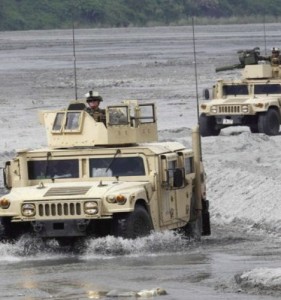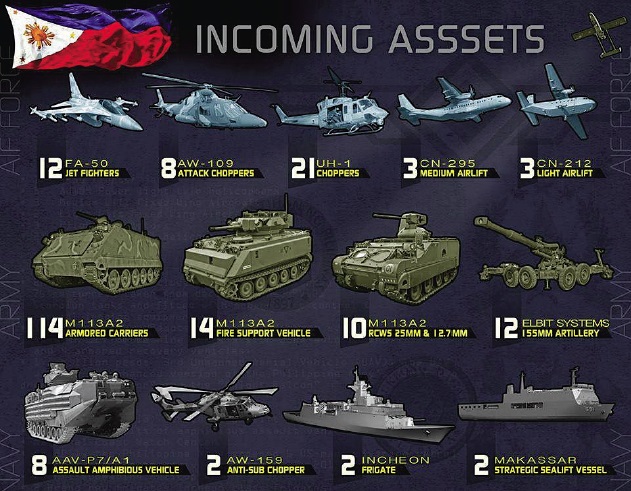Only very recently, President Obama said China must adhere to international law for the sake of peace and stability in the South China Sea (Vietnam) and the West Philippine Sea (RP). The Pacifi c Area Command head, Admiral Harry Harris, referred to the aggressive reclamation work by China on the reefs as a “Great Wall of Sand”. These artificial islands pose a threat to free passage of maritime traffic on very busy sea lanes and allow Beijing to project power into the maritime heart of South East Asia.
United States Representative Ed Royce (R-CA), a senior member of the House Foreign Affairs Sub- Committee on Asia and also the Chairman of the Sub-Committee on Terrorism wrote Secretary of the Navy Roy Mabus on November 29, 2011 calling for increased US-Philippine maritime security cooperation stating “As US Military vessels are decommissioned, I ask that you give utmost consideration to transferring them to the Philippines. I believe that the RP, through virtue of the treaty alliance with the US and its major non-NATO ally status as well as US interest in seeing the freedom of navigation upheld in the South China Sea should be given top priority as materiel becomes available.”
During the incumbency of Senator Sam Nunn as Chairman of the US Senate Committee on Armed Services, he committed to give 6 ships then docked at Suisun Bay in California to the Philippines. This was through the efforts of some Filipino community leaders in California. For some reason, this did not push through. This same patriotic group is again lobbying with the Senate Committee presently headed by Senator John McCain.
The countries in SEA have taken steps to modernize their militaries in response to these threats. The RP has lagged behind its neighbors for reasons stated earlier. Presently Indonesia, Malaysia, Vietnam and Singapore have late-generation jet fighter aircraft and missile armed surface combatants and submarines. As yet the RP does not have these.
President Aquino realized that the RP must create a “minimum credible deterrent” to hold on to our valid South China Sea claims. Transfer of decommissioned/mothballed ships and aircraft under the Excess Defense Articles (EDA) program will further both US and RP interests. 
Part of the newly developed “desired force mix” of the Philippine Navy (PN) could be met by transfer of these assets now decommissioned or due for decommissioning:
- Oliver Hazard Perry class Frigates (FFG-7) for Anti-Submarine Warfare and Anti-Air Warfare.
- Hamilton Class Weather Heavy Endurance Cutter (WHEC) for maritime domain awareness and protection of our Exclusive Economic Zones.
- Cyclone Class Coastal Patrol Interdiction Craft (CPIC) for surveillance and interdiction of coastal waters between RP, Indonesia and Malaysia against the Jemaah Islamiyah, a militant Islamic terrorist organization. The area is also a hotbed of piracy and smuggling.
These vessels should retain their whole armament and sensor systems to ensure inter-operability with US and Allied forces.The items requested will not upset the balance of power in the region. If at all, this will bring us closer to parity with the naval forces of our neighbors.
Also during the visit of President Obama to the RP last year, President Aquino requested for a squadron of refurbished ex-US Air Force F-16 jet fighters for defense of RP air space. Our last F-5A jet fighter aircraft was retired 10 years ago.
Additionally, the May 2012 report published by the Center for a New American Security (CNAS), a Washington D.C. based thinktank wrote that the RP requires, “an affordable force of 4 -6 small submarines for credible defense against a growing Chinese belligerence in the South China Sea.” Due to budget constraints, the RP projects the acquisition of submarines by 2020 yet, which may be too late considering the frenzied Chinese reclamation activities.
How do we fund this? In addition to the need to set an adequate funding program, there are proposals to fl oat government bonds to help fund the AFP Modernization Program, largely targeting the overseas Filipinos. Not only are they financially stable but they also retain patriotic feelings for the motherland as evidenced by protests in front of the Chinese embassies around the world after the Scarborough Shoal affair.
 When this writer inquired about the matter from a vice-president of one of the bigger banks, he agreed it is a very feasible idea, with a promise of solid investment with a guaranteed rate of return. During World War 2, the U.S. relied heavily on these “Victory Bonds” to fund the war effort.
When this writer inquired about the matter from a vice-president of one of the bigger banks, he agreed it is a very feasible idea, with a promise of solid investment with a guaranteed rate of return. During World War 2, the U.S. relied heavily on these “Victory Bonds” to fund the war effort.
Acquisition of second hand but still capable ships and aircraft will allow us to rapidly build up to our minimum required defense posture in the short term. Given what is at stake however, as a long term measure we should also come up with our own imaginative and innovative actions in support of the AFP Modernization Program, including the development of a viable defense industry. Indonesia, Thailand, Taiwan, Malaysia and Singapore are way ahead in this regard. Presidents Ferdinand Marcos and Fidel V. Ramos undertook steps along these lines but their efforts died because of lack of support from their successors.
In the late 1960’s the American Jet Industries (AJI) built a jet-powered primary trainer called the Pinto. An improved version, the Super Pinto was marketed as a light attack aircraft. The prototype, together with the drawings and production rights, were purchased by the Philippine Air Force (PAF), which planned to build the aircraft as the CALI Pinto. It is considered much more sophisticated than the Italian S.211 used by the PAF today.
In the 1970’s during the FM era, the Self Reliant Defense Posture (SRDP) project “Santa Barbara”, the Multiple Rocket Launch Systems “SUMPAK” and the “BONGBONG” Surface-to-Surface missile were successfully tested in Fort Magsaysay and at Caballo Island.
In the FVR era, the Philippine Aerospace Defense Company (PADC) produced under the SRDP a single engine trainer/counter-insurgency plane “Defiant” and a light utility helicopter “Hummingbird”. Perhaps we could initiate re-starting these worthwhile projects? After all, we will not be starting from scratch! The logical step in establishing an aerospace industry is the production of trainer aircraft initially before moving to more advanced types.
The RP possesses the infrastructure for a viable defense industry. Established companies like PADC, an attached agency of the Department Of Transportation and Communication, the Asian Aerospace Corporation, (a representative of the former McDonnell Douglas in the Philippines) and the Dornier Technology Philippines all engage in design, manufacture, repair and maintenance of aviation assets.
The RP is the fourth largest shipbuilder in the world and the lead ship repair hub in Asia. Giants like Hanjin of Korea, Tsuneishi of Japan and Keppel of Singapore have major operations here due to available skilled labor and technical resources. We acquired the design and rights of the former Royal Navy Peacock class corvettes when we acquired them from the former Hong Kong Squadron. This class could form the basis for missile armed PN sea craft.
Lack of support and the absence of political will have largely handicapped the SRDP. In 2016 let us elect to top positions of government people of integrity, honesty and political will.
*Major Gen Ernesto B. Calupig (ret) is a military consultant to Congressman Rodolfo G. Biazon, Chairman of the House of Representatives Committee on Defense and Security*Major Gen Ernesto B. Calupig (ret) is a military consultant to Congressman Rodolfo G. Biazon, Chairman of the House of Representatives Committee on Defense and Security
